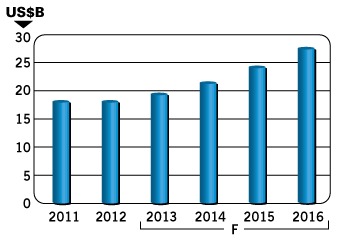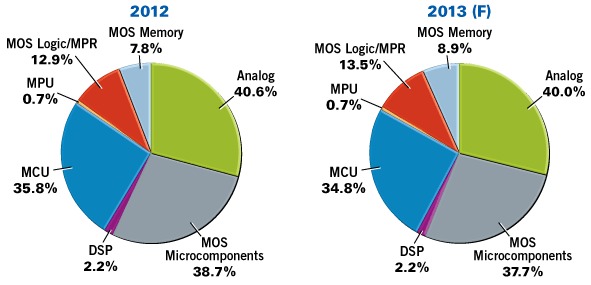New automotive technologies that go beyond touchscreens, satellite radio, and voice-activated GPS commands are being tested and improved, and will soon begin to appear in many more new car models, resulting in solid growth for the automotive IC market through 2016, according to the 2013 edition of IC Insights’ IC Market Drivers—A Study of Emerging and Major End-Use Applications Fueling Demand for Integrated Circuits.

Military-like night-vision systems that quickly identify pedestrians, animals or road hazards in low-light conditions; airbags stowed in shoulder harnesses of seatbelts; and the ability for drivers to customize the look of their dashboard instrument panels are examples of systems that are available in a select number of cars now, but will soon become available in many more vehicles. Along with backup cameras, electronic stability control, active-cruise control, and several other systems covered in the IC Market Drivers report, emerging electronic systems are forecast to help the automotive IC market grow 52% from $18.2 billion in 2012 to $27.7 billion in 2016. This growth translates to an average annual increase of 11% for the automotive IC market.
Analog ICs and MCUs are forecast to benefit most from the increasing electronic content within automobiles. According to the IC Market Drivers report, analog ICs accounted for 41% of the 2012 automotive IC market (Figure 2). Analog ICs are used in “traditional” applications such as to gauge input functions like speed measurement and for output functions like opening and closing power windows and adjusting power seats. One of the newer applications for analog ICs in cars is LED lighting. Depending on the application, LED drivers and various converters are used to supply constant current despite variations in battery voltage.
Microcontrollers accounted for 36% of the automotive IC market in 2012. 16-bit applications in chassis and safety applications (lane-detection warning, hands-free telematics, etc.) are increasing, but enhanced 8-bit and low-end 32-bit MCUs are competing for many of the same sockets as 16-bit controllers. Applications like anti-skid braking and airbag systems are solidly 16-bit now, but are transitioning to larger bit widths. Electronic parking assist could be a new sweet spot for 16-bit MCUs. These systems typically use two to four (but as many as eight) ultrasonic sensors to detect objects near the vehicle. Processing the additional information drives the requirements into the domain of 16-bit devices.
The 32-bit chips are incorporated into powertrains to handle functions such as electronic throttle control, cylinder deactivation, variable valve timing, and fuel injection, and in next-generation chassis and safety systems including active high-end electronic stability control, complex smart airbag systems, and more. In addition, 32-bit MCUs are used to process sophisticated, real-time sensor functions within safety and crash-avoidance systems.
Gesture recognition is a growing trend that is being incorporated both inside and outside the car. 32-bit MCUs are at the core of many emerging gesture-recognition systems and in many ways, they are an extension of gesture-recognition technology found onboard in game controllers.
Though the automotive market represents only about 7% of total IC sales, increasing electronic system content in motor vehicles is forecast to result in this segment being one of the fasting-growing end-use categories through 2016.






